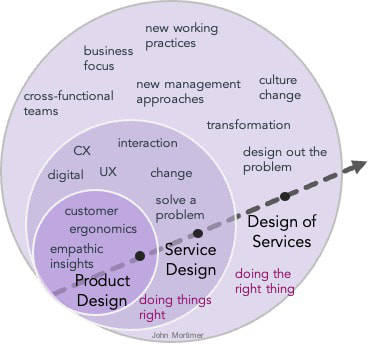Systemic design for complexity using systems thinking
Systemic design is...
when we understand and design organisations using systems thinking, design and change methods together. Looking at what makes an organisation really work.
when we understand and design organisations using systems thinking, design and change methods together. Looking at what makes an organisation really work.
|
As markets and customer demands evolve, and maintain a competitive edge, organisations continue to search for a whole approach to business.
Understanding how to design services and organisations is always challenging, particularly when confronted with complex and agile services. What can make a real difference is to design for the complexity that we find in the reality of organisations, using systems thinking. - Learning to respond to the competitive or regulatory environment. - Understanding the real needs of customers, and how to ensure we are always onto of this knowledge. - How to translate customer needs directly into the way we work. In this website there are examples where systems thinking is used to comprehend all the aspects of a whole service, and demonstrate the outcomes with the systemic design, the staff, and leadership. Self managed teams, new management behaviours, delegated decisions, effective teams, agile working; all the hallmarks of progressive successful organisations. |
Innovative techniques come from those few who truly pioneer effective and efficient services, by redefining their approaches. The old ways of managing are being left behind... Re-designing services and organisationsThe development of designing services, change methods, Lean, etc, often focuses on digital tools and project management tactics for boosting the re-design of services. What is more hidden and less obvious is why a service works throughout the organisation. The service may well be riddled with poor performance, waste, and disgruntled staff, and if we simply design on top of these, then we lock in poor performance. Typically we find that over 20 - 50% of activities could be designed out.
Systemic approaches are very good at helping to understand the whole service, and therefore allows managers and designers to delve far deeper into the design of services, so that real transformation can occur - rather than simply improving what we already have. This leads to services becoming optimised and apart to the needs of customers. Complexity
In the past we have not been very good at adapting management to deal with the rapid change and complex situations that we now find ourselves in. Complexity seems to be suddenly all around us in the business world. At least now, we are recognising that complexity is now something that has to be understood as a key factor in designing and managing services and organisations systemically rather than individually.
Services that contain complexity, will require very different approaches to design than they would for a logical service. Systemic approaches to design replace and remedy the inability of traditional process design that often fails to achieve anything more than satisfactory outcomes or superficial change. Systemic concepts respond to complexity by creating an adaptable and flexible way of allowing local decisions, engaging with staff directly to create empowered and flexible working. That is a step change to the static mechanical design of yesterday.
Systems changeThis is the ability to view, understand, and design and act on the service and the organisation holistically. We understand how the system truly behaves, so we can therefore make a real difference in its design.
The outcome is a new type of understanding and methodology where service design and change can have a far deeper impact. And it can successfully used to help managers to deal with complexity.
Systems leadershipThe current mindset and skills that leaders are taught today, have been around for decades. They originated from the core of the industrial revolution, based on a simplistic view of how organisations should work.
An increasing number of leaders sense a growing concern and dissatisfaction with yesterdays approaches, and they are looking around for something better. One that more reflects the reality of how organisations work and how to deal with that complexity.
It has the makings of a new profession, on how to manage correctly... |
The triple diamond systemic design framework
Systemic design gives us a way to create different ways of thinking and working. The method of working with a service to help them to change can be summarised like this systemic design framework, that takes the original diamond design from the Design Council and develops it into systemic methods like the triple diamond:
Understanding that follows from the systemic framework;
- organisations and how they work through people rather than procedures,
- sensemaking and how to deal with compelxity.
- the paradigms that we work within, and how we can become innovative.
- how we can behave towards each other to foster true collaboration.
- how we can create value creating services.
- organisations and how they work through people rather than procedures,
- sensemaking and how to deal with compelxity.
- the paradigms that we work within, and how we can become innovative.
- how we can behave towards each other to foster true collaboration.
- how we can create value creating services.
Delving further into systemic design methods and principles






